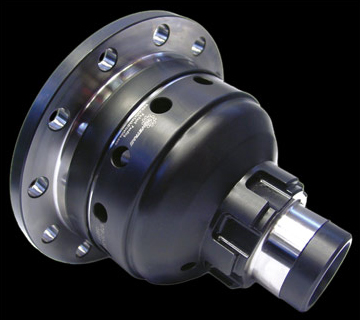LSD Wavetrac sale
 Wavetrac® At A Glance:
Wavetrac® At A Glance:• Innovative:
Patent pending Wavetrac® design automatically improves grip in low traction conditions. This feature is truly innovative and unlike any other torque biasing diff design.
• Superior Materials:
9310 steel gears run in case-hardened billet steel bodies. ARP® fasteners used throughout.
• Maintenance Free:
As supplied new, the Wavetrac® differential will perform a lifetime of service without maintenance or rebuilds.
• Customizable:
If desired, you can alter the diff’s behavior to suit your needs using optional components.
• Limited LIFETIME Warranty:
All Wavetrac® differentials include a transferable, Limited Lifetime Warranty.
What makes a Wavetrac® Different?
To best understand how the Wavetrac® is truly different from the other gear differentials on the market, you first have to understand the primary problem that the Wavetrac® solves.
The problem: Loss of drive during zero or near-zero axle-load conditions.</EM> </STRONG>
Zero axle-load is a condition that occurs during normal driving, but creates the most noticeable problems when driving in extreme conditions. Zero or near-zero axle-load is the condition that exists when there is ‘no-load’ applied through the drivetrain, when one drive wheel is nearly or completely lifted (often in aggressive cornering). It also occurs during the transition from engine driving a vehicle to engine braking and back, even with both drive wheels firmly on the ground.Here’s how that loss of drive hurts you:
1) If you lift a wheel, all gear diffs except Wavetrac®, will NOT power the other wheel.
2) During the transition from accel to decel, all gear diffs except Wavetrac®, do nothing.
Why does this happen?2) During the transition from accel to decel, all gear diffs except Wavetrac®, do nothing.
All gear LSDs (including Torsen®, Truetrac®, Quaife®, Peloquin, OBX, etc.) work in basically the same manner: they divide the drive torque between the two axles, applying drive to each side, up to the available grip of each tire. The amount of drive torque one wheel can get over the other is described as the bias ratio, a measure of the torque split across the axle.
Standard, open differentials have a bias ratio of 1:1. They can only apply as much drive torque as there is available traction at one wheel. When one wheel loses grip, the total available drive is lost as well (at a 1:1 ratio). All your power goes out the slipping wheel - along the path of least resistance.
Torque biasing differentials offer increased bias ratios over open differentials. For example, if a diff has a bias ratio of 2.5:1, then it can apply drive torque to the wheel with the most traction (gripping wheel) at 2.5 times the traction limit of the wheel with the least traction (slipping wheel). This is a significant improvement over an open diff… most of the time.
The problem is that when one tire has LITTLE or NO grip (zero axle-load), the other wheel gets ZERO DRIVE, because (basic math here): 2.5 x 0 = 0.
Lift a wheel (or substantially unload a wheel) and you get zero axle-load on that side - that means that during the time the wheel is unloaded, the typical diff will NOT power the wheel that’s still on the ground. No matter how high the bias ratio, you get no power to the ground.
During the transition from accel to decel, where you have near zero torque on the axle, even if the wheels are on the ground, the typical diff is unable to begin applying drive torque until AFTER the zero torque condition is over. While this condition is generally short-lived, the fact that most diffs can do nothing during that time means that there will be a delay once the zero torque condition stops - creating a reaction time in the driveline.
Go here for vehicles & Part Numbers
__________________
Last edited by Merv; 07-16-2010 at 02:26 PM.







